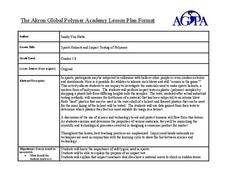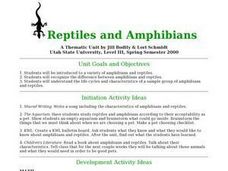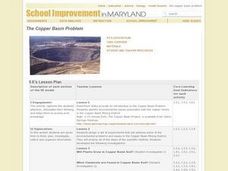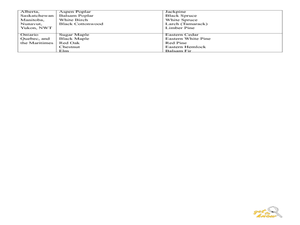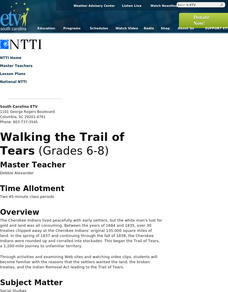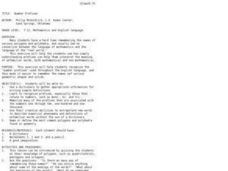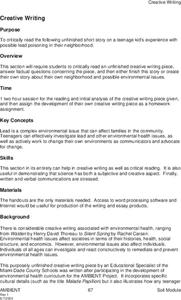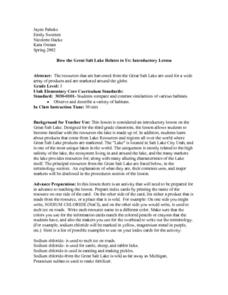Curated OER
Sports Helmets and Impact Testing of Polymers
Learners examine the importance of good quality safety gear. In this investigative lesson, students will tests various polymers, collect data, and analyze the data to determine which polymer is best for safety helmets. They will design a...
Curated OER
Project Whistlestop:Missouri Vacation Learning Unit
Fourth graders reserach the state of Missouri. In this Missouri History lesson plan, 4th graders plan a vacation to a region of Missouri. Students work in collaborative groups to determine all aspects of the trip. Students use math...
Curated OER
Insects Are Helpful!
Students see that insects do lots good and are very valuable to humans and nature. This is part of an ongoing effort to dispel fears of insects. They rotate through a series of centers that have examples of how insects contribute to our...
Curated OER
Environmental Health Hazards and Children
Learners are introduced to the environmental hazards their community is facing. In groups, they develop a list of the ways humans have changed the Earth and how these changes have lead to environmental hazards. They record their...
Curated OER
Water Creative Writing
Students red and discuss an example of a biographical essay. They read The Last of the Falling Tide by Car Hiassen, answer factual questions concerning the work, and create their own story about a natural place they are familiar with ,...
Curated OER
The Anaconda
Young scholars examine basic facts about the anaconda. They discuss the length of an anaconda, estimate the length of 33 feet, compare their estimate to the actual length, and decorate the paper snake with colored scales.
Curated OER
Is a Pulley a Special Kind of Lever?
Fifth graders use information from their text to read and discuss pulleys and levers. They examine a top sketch of the arrangement of a fixed pulley. Working in groups, 5th graders perform experiments to test the effect of using a pulley...
Curated OER
The Copper Basin Problem
Students view a video about how human actions impact the environment. They design a set of experiments to address some of the problems and issues raised by the video.
Curated OER
Does that Sound Right to You?
Ninth graders are introduced to the components of compressional and transverse. They practice answering speed problems involving different mediums that waves travel trhough and then review the wave PowerPoint. They then visit physics...
Curated OER
Projectile Motion
Students determine the angle of launch that will give a projectile its greatest range. In this projectile motion lesson plan, students recognize that the motion of a projectile results from the combined horizontal and vertical...
Curated OER
Get to Know Trees
Students recognize the characteristics of trees by using their five senses. In this trees lesson, students observe and record the characteristics of trees on a field trip. Students then are blindfolded and use their senses to identify...
Curated OER
What If?
Young scholars examine the relationship between farmers and consumers. In this agriculture lesson, students explore supply and demand as they play an economics-based game.
Curated OER
Flower Pot Salad Bar
Students discuss the connection between a flower pot and wholesome food by creating a salad. In this healthy eating lesson, students utilize numerous fresh vegetables to create a classic salad in a flower pot. Students write...
Curated OER
You’re Tugging at Me!
Students study the sliding and rolling friction. In this forces lesson students divide into groups and use a cart to examine the amount of force that is used to move objects.
Curated OER
Comparing mtDNA Sequences to Learn about Human Variation
This computer-based lesson will enable students to test their notions of "racial" similarity and difference by comparing mtDNA sequences as the students do in the first episode of RACE - The Power of an Illusion.
Curated OER
Walking the Trail of Tears
Middle schoolers, through the use of examining video clips and Websites, become familiar with the reasons that the settlers wanted the land, broke treaties, and initiated the Indian Removal Act leading to the Trail of Tears.
Curated OER
Number Prefixes
Young scholars recognize the number prefixes used throughout the English language. They identify the shapes and the prefixes that are associated with them.
Curated OER
Language Arts: Twinning At-Risk Students
Students at-risk in high school and primary grades pair up to read and write together. They create books modeled after authors and illustrators. They hold a parents' day to display their completed books.
Curated OER
Creative Writing
Students criticially read an unfinished creative writing piece, answer factual questions concerning the piece, and then finish the story or create their own story about their own neigborhood and possible environmental issues.
Curated OER
How Plants Help Us Breathe
Third graders discuss how humans breathe and how plants help us to stay alive. In groups, they identify and label the different parts of plants and describe their functions. They compare and contrast the ways plants and animals breathe...
Curated OER
Biological Concepts
Students perform a transection of a redworm. They discuss spinal cord injuries in humans. Students compare the ability of the redworm to regenerate the ventral nerve cord with the inability of humans to repair damage to the dorsal nerve...
Curated OER
How the Great Salt Lake Relates To Us
Third graders name at least three resources that come for the Great Salt Lake. They describe at least one product that is made from each resource. They name and locate on a map at least five different geographic regions where Great...
Curated OER
Lake Effect
Fourth graders explore some of the effects Great Salt Lake has on Utah's local weather/temperature moderation, lake effect storms, and temperature inversions. They observe the differences of specific heat between soil and water and...
Curated OER
Plant Systems
Second graders learn about plant systems and how plants grow and function. In this plant lesson plan, 2nd graders collect data based on roots, leaves, terrariums, plant uses, and locations of certain kinds of plants. They fill out...


